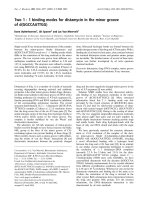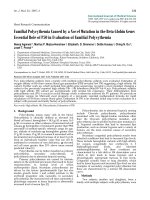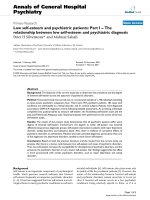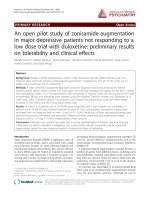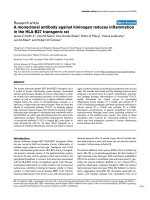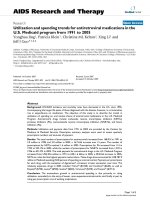Báo cáo y học: "Health technology assessment review: Computerized glucose regulation in the intensive care unit - how to create artificial control" ppsx
Bạn đang xem bản rút gọn của tài liệu. Xem và tải ngay bản đầy đủ của tài liệu tại đây (336 KB, 7 trang )
Available online />Page 1 of 7
(page number not for citation purposes)
Abstract
Current care guidelines recommend glucose control (GC) in
critically ill patients. To achieve GC, many ICUs have implemented a
(nurse-based) protocol on paper. However, such protocols are
often complex, time-consuming, and can cause iatrogenic hypogly-
caemia. Computerized glucose regulation protocols may improve
patient safety, efficiency, and nurse compliance. Such computerized
clinical decision support systems (CDSSs) use more complex logic
to provide an insulin infusion rate based on previous blood glucose
levels and other parameters. A computerized CDSS for glucose
control has the potential to reduce overall workload, reduce the
chance of human cognitive failure, and improve glucose control.
Several computer-assisted glucose regulation programs have been
published recently. In order of increasing complexity, the three main
types of algorithms used are computerized flowcharts, Proportional-
Integral-Derivative (PID), and Model Predictive Control (MPC). PID
is essentially a closed-loop feedback system, whereas MPC models
the behaviour of glucose and insulin in ICU patients. Although the
best approach has not yet been determined, it should be noted that
PID controllers are generally thought to be more robust than MPC
systems. The computerized CDSSs that are most likely to emerge
are those that are fully a part of the routine workflow, use patient-
specific characteristics and apply variable sampling intervals.
Introduction
There is widespread consensus [1] that hyperglycaemia
should be treated with insulin in patients in the ICU, although
appropriate glucose levels achieved through glucose control
(GC) are still under debate. Insulin therapy in ICU patients,
even with a moderate glucose target range, is complex and
time consuming, particularly since insulin-induced severe
hypoglycaemia should be avoided. In most ICUs, protocols
for GC are paper-based and nurse-driven. However, even
with this form of standardization medication errors frequently
occur and play a major part in overall patient safety, which is
a key issue in all healthcare systems. For safety and
efficiency, computerized clinical decision support systems
(CDSSs) appear to be superior to standard paper protocols.
Patient data management systems and computerized
physician order entries are increasingly being used in the
ICU, both with and without decision support. This review
focuses on the progressively more complex approaches that
have recently been introduced to achieve GC. Successful
implementation of computer-guided GC is of relevance to
other ICU domains, since the basic titration principle behind
GC (for example, increase insulin infusion if glucose is high)
holds for numerous other clinical ICU problems. Although this
is not a formal exhaustive review, this paper discusses several
important studies on paper protocols and development of
computer assisted methods, including flowcharts,
Proportional-Integral-Derivative (PID) and Model Predictive
Controllers (MPC).
Glucose control with paper protocols
Hyperglycaemia frequently occurs in critically ill patients and
is strongly associated with adverse outcome in patients with
acute myocardial infarction [2], stroke [3], and trauma [4,5].
Also in a heterogeneous ICU population hyperglycaemia was
associated with increased hospital mortality [6,7]. This
observation raised the interesting question of whether
normalizing blood glucose (BG) improves outcome. In 2001
van den Berghe and colleagues [8] showed a one-third
mortality reduction in surgical ICU patients treated with
Review
Health technology assessment review: Computerized glucose
regulation in the intensive care unit - how to create artificial
control
Miriam Hoekstra
1
, Mathijs Vogelzang
2,3
, Evgeny Verbitskiy
4,5
and Maarten WN Nijsten
6
1
Departments of Anesthesiology and Cardiology, University Medical Center Groningen, 9700 RB Groningen, the Netherlands
2
Department of Cardiology, University Medical Center Groningen, 9700 RB Groningen, the Netherlands
3
Google, CH-8002 Zurich, Switzerland
4
Department of Dynamical Systems and Mathematical Physics, Research Institute for Mathematics and Computing Science, University of Groningen,
9700 AK Groningen, the Netherlands
5
Information and System Security, Philips Research, 5621 BA Eindhoven, the Netherlands
6
Department of Intensive Care, University Medical Center Groningen, 9700 RB Groningen, the Netherlands
Corresponding author: Miriam Hoekstra,
Published: 16 October 2009 Critical Care 2009, 13:223 (doi:10.1186/cc8023)
This article is online at />© 2009 BioMed Central Ltd
BG = blood glucose; CDSS = clinical decision support system; CGMS = continuous glucose monitoring system; GC = glucose control; MPC =
Model Predictive Control; PID = Proportional-Integral-Derivative.
Critical Care Vol 13 No 5 Hoekstra et al.
Page 2 of 7
(page number not for citation purposes)
intensive insulin therapy (using a paper protocol for insulin
infusion). However, subsequent high-quality controlled trials
[9-11] and a large cohort study [12] in both medical and
surgical ICU patients could not replicate this mortality benefit.
The recently published international NICE-SUGAR (Normo-
glycaemia in Intensive Care Evaluation - Survival Using
Algorithm Regulation) trial [13] demonstrated in 6,104
patients that ‘tight’ GC with a target of 4.5 to 6.0 mmol/L was
associated with a higher mortality. The investigators used a
computer-assisted glucose regulation protocol. In the meta-
analysis that followed (including the NICE-SUGAR study
data), no mortality benefit was demonstrated in the tight
glycemic control group [14]. However, because there is con-
sensus about avoiding serious hyperglycaemia, GC in ICU
patients is still recommended so that glucose levels should
be kept at approximately <8.0 mmol/L [1,13].
To achieve desired glucose levels, insulin therapy is required
in most ICU patients. GC requires intensive monitoring of
glucose levels with frequent adjustments of insulin therapy. A
first step in managing GC is the use of protocols that allow
physicians and nurses to decide unambiguously how much
insulin should be administered. The recommendations of
these protocols are generally based on previous glucose
levels and insulin dosing according to a ‘sliding scale’
protocol (a predetermined amount of insulin is administered
according to the actual BG) or ‘dynamic’ protocol (the
dosage of insulin is changed by a certain amount, according
to the actual BG) [15]. Given the frequency of BG sampling,
it rapidly became apparent that the nurses who care for the
patient should have a central role in executing GC.
Standardizing GC by a nurse-managed protocol has been
found to improve safety and efficiency of GC [16].
Hypoglycaemia
One of the main challenges in achieving glycaemic control is
minimizing the risk of hypoglycaemia. Hypoglycaemia can
cause serious complications and should be prevented in
critically ill patients [17]. In several studies an increased
occurrence of severe hypoglycaemia was strongly associated
with tight glycemic control. Two large trials investigating the
clinical effects of strict GC that were prematurely ended
showed high rates of iatrogenic hypoglycaemia [10,11].
Although the overall evidence suggests that the beneficial
effects of insulin therapy may outweigh the possible negative
effects of hypoglycaemia [18], fatalities occurring due to
iatrogenic hypoglycaemia are not acceptable. A balance must
be struck between the preferred level of control and the
number of measurements. To achieve GC with a low incidence
of hypoglycaemia without excessive BG sampling, more
complex computer supported algorithms are required that
manage the patients with an increased risk for hypoglycemia.
Introduction of computerized glucose control
For many years, computer software has been recognized as a
promising tool to improve clinical practice as many adverse
events can be traced back to preventable human errors.
These so-called CDSSs are information systems designed to
improve clinical decision making using characteristics of the
individual patient. Implementations of these systems have
been shown to reduce serious medication errors [19] and
improve adherence to recommended care [20]. In the past
few years several computer directed glucose regulation
programs have been investigated for their effectiveness and
safety in critically ill patients. We performed a literature
search (PubMed, Cochrane and Medline) to find published
computer-based intravenous insulin protocols that were
designed for critically ill patients and tested in an ICU setting
(in at least 15 patients). Table 1 summarizes the 19 identified
studies [13,21-38].
How to create artificial control?
Devising an algorithm for controlling blood glucose is a
challenging task. The algorithm should be evaluated to be
safe, robust and efficient for a population of patients with a
wide range of clinical conditions. To date, three types of
algorithms have been considered for BG regulation:
(heuristic) paper-based or equivalent computerized flow-
charts, PID and MPC.
Computerized flowcharts
The first flow-chart protocol was based on studies by van den
Berghe and colleagues [8,9]. It allows nurses to determine (at
the bedside) the necessary adjustment of the insulin pump
based on the most recent BG value and the trend (using the
number and levels of past BG values to determine the trend).
In case of extremely low BG or other exceptional cases,
special actions are planned. The paper-based flow-chart
protocol can easily be converted into a computerized form
(see, for example, Thomas and colleagues [36] and Laha and
colleagues [28]). Furthermore, the use of computers allows
an increase in the sensitivity (resolution) of the titration part,
for example, in the Vanderbilt protocol [21]. The formula uses
a simple multiplier, which is determined and adjusted
according to previous BGs (BG in mmol/L; multiply multiplier
by 18 for BG in mg/dl):
Insulin dose (U/h) = Multiplier × (BG – 3.3) (Equation 1)
where the multiplier is adjusted by 0.01 up or down when two
consecutive BGs are above 6.1 or below 4.4 mmol/L, respec-
tively; in the case of extreme values (<3.3 or >11 mmol/L) the
multiplier is adjusted by 0.02, and in the case of BG <3.3, the
insulin dose becomes zero. Boord and colleagues [21], and
later Dortch and colleagues [24], demonstrated an
improvement in overall GC compared to a previous manual
protocol. At the same time, a glucose sample was required
approximately 18 times per day.
PID control
A titration formula like Equation 1 puts the control algorithm in
the class of the so-called PID controllers. These are the most
Available online />Page 3 of 7
(page number not for citation purposes)
Table 1
Summary of published computer-assisted glucose regulation protocols, designed for critically ill patients
Target range Measurements per
Reference N Patient type APACHE II (mmol/L) Performance Hypoglycaemia
a
patient per day
Boord et al. [21] 204 Surgical ICU ? 4.4 to 6.1 49% of time in range 0.2% <2.2 mmol/L ~18 (12 to 24)
b
Cordingley et al. [22] 16 Mixed ICU 16.6 4.4 to 6.1 63% of time in range 0 <2.2 mmol/L 10.9
Davidson et al. [23] 5,808 General medical ? Variable ‘Stable glucose’ 0.6% <2.8 mmol/L ~18 (12 to 24)
b
and surgical floors
Dortch et al. [24] 243 Trauma ICU ISS 27.5 4.4 to 6.1 42% of measurements in range 0.2% <2.2 mmol/L 10.7
Hermayer et al. [25] 66 CABG ? 4.4 to 6.7 Mean BG 6.4 mmol/L 0.10% <2.2 mmol/L 16.2
c
Horovorka et al. [26] 30 Cardiac surgery ? 4.4 to 6.1 60% of time in range 0 <2.9 mmol/L 16
Juneja et al. [27] 2,398 Mixed ICU ? 4.4 to 6.1 61% of measurements in range 0.4% <2.8 mmol/L ~18 (12 to 24)
b
Laha et al. [28] 661 Mixed ICU 16 4.5 to 7.2 95% of measurements in the 1.7% of patients with a single ~12 (6 to 24)
d
range 3.7 to 12.1 mmol/L episode <2.2 mmol/L
Meyenaar et al. [29] 179 Mixed ICU 13 4.5 to 7.5 53% of time in range 0.05% <2.2 mmol/L 3.4
Morris et al. [30] 775 Mixed ICU 21.8 4.4 to 6.1 42% of measurements in range 0.33% <2.2 mmol/L ~12 (6 to 24)
d
NICE-SUGAR [13]: 3,054 Mixed ICU 21.1 4.5 to 6.0 Mean time-weighted BG 6.8% <2.2 mmol/L ~12 (6 to 24)
d
intensive control 6.4 mmol/L
NICE-SUGAR [13]: 3,050 Mixed ICU 21.1 8.0 to 10.0 Mean time-weighted BG 0.5% <2.2 mmol/L ~12 (6 to 24)
d
conventional control 8.0 mmol/L
Pachler et al. [31] 25 Medical ICU 26.6 4.4 to 6.1 HGI = 0.4 mmol/L 1 episode <2.2 mmol/L 12.3
Plank et al. [32] 30 Cardiac surgery 11.4 4.4 to 6.1 52% of time in range 0 <2.2 mmol/L 24
Rood et al. [33] 66 Mixed ICU 19.5 4.0 to 7.0 54% of time in range 0.09% of time <2.5 mmol/L 9.9
c
Saager et al. [34] 20 Cardiac surgery ? 5.0 to 8.3 84% of time in range 5 episodes <3.3 mmol/L 24
Shulman et al. [35] 50 Mixed ICU 23 4.4 to 6.1 23% of time in range 0.04% of time <2.2 mmol/L 12.7
Thomas et al. [36] 603 Mixed ICU 14.4 5.4 to 7.1 85% of measurements <8 mmol/L 19 episodes ~12 (6 to 24)
d
Toschlog et al. [37] 128 Trauma ISS 24.5 4.4 to 7.2 Mean BG 6.4 mmol/L 32% of patients with a single ?
episode <2.8 mmol/L
Vogelzang et al. [38] 2,800 Mixed ICU 14 4.0 to 7.5 67% of time in range 0.04% <2.2 mmol/L 5.9
a
Hypoglycaemia is represented as the proportion of all measurements, unless otherwise specified.
b
No exact data, but protocol has ‘hourly to two-hourly measurements’.
c
Calculated from
number of measurements and length of stay.
d
No exact data, but protocol has ‘hourly to four-hourly measurements’. APACHE, Acute Physiology and Chronic Health Evaluation II; BG, blood
glucose; CABG, coronary artery bypass grafting; HGI, hyperglycaemic index; ISS, Injury Severity Score; NICE-SUGAR, The Normoglycaemia in Intensive Care Evaluation - Survival Using
Algorithm Regulation.
widely used controllers in industrial applications. Typical
examples are the kitchen furnace and automotive cruise
control. The basic idea of PID control is easy to explain:
deviation of the controlled quantity (BG in our case) from the
target is corrected by adapting the control parameter (insulin)
using a linear combination of absolute deviation, trend, and the
sum of past deviations. In fact, a PID controller has already
been used in the BioStator, the first device for ‘glucose
clamping’, developed in the late 1970s [39]. Equation 1
utilizes only the proportional (P) part of the PID control.
Vogelzang and colleagues [38,40] also use the derivative (D)
component. For the rationale behind the application of the
integral (I) part, see Wintergerst and colleagues [41].
Model predictive controllers
A great deal of work has been invested in mathematical
modelling of glucose regulation. Models of various complexi-
ties have been constructed in the past 50 years, as recently
comprehensively reviewed by Chee and Fernando [42].
Deterministic mathematical models can also serve as a basis
for the development of control algorithms. Given the model
equations and the values of all model parameters, one is able,
in principle, to precisely compute the glucose evolution in
response to any insulin infusion strategy. In theory, this allows
a selection of an optimal insulin infusion scenario. In practice,
however, mathematical models rarely exactly describe reality,
and a large number of parameters need to be estimated, which
will inevitably lead to errors in prediction of glucose response.
An example of such complex MPC was developed by the
CLINICIP (Closed Loop Insulin Infusion in Critically Ill
Patients) group. The ultimate goal is a closed loop system for
glycemic control. Plank and colleagues [32] describe, in a
multicenter randomized controlled trial, glucose management
with the MPC program in 30 patients after cardiac surgery.
Compared with routine protocols for glucose regulation, the
time within target range improved significantly (19% to 52%)
during the first 24 hours postoperatively. However, an hourly
glucose sample was necessary, which substantially increased
the workload of the ICU nursing staff. Thereafter, the
algorithm was enhanced with a variable sampling interval
based on the accuracy of the glucose prediction. The
improved protocol (eMPC) resulted in a 50% drop in
sampling frequency [31] and maintained effective glucose
control in different ICUs, with different (nutritional) protocols
and during cardiac surgery [22,26]. The authors report that
the program was safe in 30 patients. It should be noted,
however, that the published incidence of hypoglycaemia, a
key safety indicator, varies from less than 1% to a few
percent, thus rendering a sample size too small to assess
such a safety parameter.
PID versus MPC
The following might serve as a caricature explanation of the
difference between PID and MPC. Suppose a person wants
to drive a car on a mountain road. The control (equivalent to
the art of driving) consists of two continuous inputs: steering
and throttle. The PID approach would be analogous to a
driver negotiating the road by continuously adjusting the input
parameters, correcting deviation from the ideal line,
proceeding along as the new corners or obstacles appear in
front. The MPC strategy would be analogous to studying the
whole road and selecting the driving strategy before the
departure. Note that even the MPC approach does not
guarantee 100% success as the strategy might have to be
adjusted to changing conditions like rain, other road users,
and so on. This example is illustrated in Figure 1.
The theoretical advantage of the MPC over the PID approach
is that the ‘intelligent’ control algorithm could be able to
minimize glucose oscillations and keep glucose within the
target range better than PID controllers. This, however, would
require further improvement of not only the mathematical
models and the parameter estimation procedures, but the
control algorithms as well, since the current results of in silico
(that is, with a virtual electronic patient) testing exhibit rather
dramatic oscillatory behavior [43].
Finally, some believe that with the envisioned introduction of
continuous glucose monitoring systems (CGMSs) in the ICU
setting, the current problem - high workload for nurses
Critical Care Vol 13 No 5 Hoekstra et al.
Page 4 of 7
(page number not for citation purposes)
Figure 1
Model Predictive Control (MPC) versus Proportional-Integrate-
Derivative (PID) control. When using MPC control, the driver
determines (‘calculates’) his driving strategy before departure after
careful investigation of the road. When he uses the correct information
(input variables), he stays on the road (yellow car), but small errors in
input variables can lead the car in the wrong direction (red and blue
cars). The drivers using PID control readjust their driving strategy often
by frequently calculating the difference with the ‘ideal’ track.
resulting from frequent glucose measurements - will reduce
considerably. Results reported in the literature strongly
suggest that, with the frequent sampling of BG, the more
transparent PID controllers are fully capable of regulating
glucose successfully. However, application of CGMSs in the
ICU setting is still hampered by a relative inaccuracy of the
existing sensors. Moreover, it must be noted that regardless
of the algorithm employed, CGMSs may not come so easily
or cheaply as originally envisioned, since the devices are
expensive and may require quite frequent BG samples as
well, albeit only for calibration purposes. For more discussion
on the combination of CGMSs and PID controllers or PID
control versus MPC control see [44-48].
Computer versus paper-based insulin
infusion protocols
Whether computer-based or paper-based, the underlying
algorithm is the crucial ‘know-how’ responsible for overall
performance. The same algorithm in paper or computer form
should have the same overall performance, provided that
nurses are easily able to use both versions and comply with
recommendations in the same way. Computer implemen-
tations probably offer higher comfort to the nursing staff. The
chance of human error grows dramatically with the complexity
of the protocol when it is implemented on paper. Therefore,
the class of all protocols potentially implementable by
humans is strictly smaller than the class of protocols
implementable on the computer.
Successful implementation of decision
support systems
To make the implementation of a computerized CDSS
successful, the algorithm used is not the only element that
must be taken into account. Kawamoto [49] performed a
systematic review to identify features critical to the success
of a CDSS and concluded that to make a program likely to
succeed, it must be fully part of the caregivers’ routine
workflow and provide the decision support at the time and
location of the actual decision making. Also transparency,
such as documentation of the reasons behind the decision
making, and a feedback mechanism (for example, an alarm as
a reminder for when a glucose sample is required) were
features leading to success. Before implementation, ade-
quate training of the nursing staff and physicians is important.
To date, no systematic studies on the costs of computerized
protocols have been published, but it is likely that a program
that requires 18 measurements per day will turn out to be
more expensive than one that requires 6 measurements per
day.
Future perspectives
To improve patient safety, more and more technology will
arise in healthcare, especially in the ICU, where the
complexity of patient care is high. A system that is effective,
safe, transparent and easy to work with has a chance to
become routine practice. An advantage of computerized
regulation is that improvements of the internal algorithm may
enable a higher level of control and safety while maintaining a
simple user interface. To date there have been no direct
comparisons made between different algorithms, so the best
approach has not been determined yet. Development of a
closed-loop system using continuous BG measurements has
been ongoing for many years. For the near future, the method
of choice for insulin therapy will still be based on intermittent
glucose sampling because the continuous techniques are not
yet reliable enough (mainly in the hypoglycaemic area) and
are expensive.
Conclusion
Computer-assisted glycemic control has proven to be more
safe and effective than paper protocols in ICU patients. A
successful system is nurse-centered, fully integrated into the
routine workflow, transparent, and uses patient-specific
information with intermittent glucose measurements and
variant sampling intervals.
Competing interests
The work of EV on glucose regulation in the ICU is supported
by the Netherlands Science Organization through the
national cluster ‘Non-linear dynamics of natural systems’. MH,
MV and MN declare that they have no competing interests.
Acknowledgements
The authors would like to acknowledge Felix Zijlstra and Iwan van der
Horst for critical reading of the manuscript.
References
1. Dellinger RP, Levy MM, Carlet JM, Bion J, Parker MM, Jaeschke R,
Reinhart K, Angus DC, Brun-Buisson C, Beale R, Calandra T,
Dhainaut JF, Gerlach H, Harvey M, Marini JJ, Marshall J, Ranieri M,
Ramsay G, Sevransky J, Thompson BT, Townsend S, Vender JS,
Zimmerman JL, Vincent JL: Surviving sepsis campaign: interna-
tional guideliness for management of severe sepsis and
septic shock. Intensive Care Med 2008, 34:17-60.
2. Capes SE, Hunt D, Malmberg K, Gerstein HC: Stress hyper-
glycemia and increased risk of death after myocardial infarc-
tion in patients with and without diabetes: a systematic
overview. Lancet 2000, 355:773-778.
3. Capes SE, Hunt D, Malmberg K, Pathak P, Gerstein HC: Stress
hyperglycemia and prognosis of stroke in nondiabetic and
diabetic patients: a systematic overview. Stroke 2001, 32:
2426-2432.
4. Wahl WL, Taddonio M, Maggio PM, Arbabi S, Hemmila MR:
Mean glucose values predict trauma patient mortality. J
Trauma 2008, 65:42-47.
5. Lipshultz AK, Gropper MA: Peri-operative glycemic control: an
evidence based review. Anesthesiology 2009, 110:408-421.
6. Krinsley JS: Association between hyperglycemia and
increased hospital mortality in a heterogeneous population of
critically ill patients. Mayo Clin Proc 2003, 78:1471-1478.
7. Vogelzang M, Nijboer JM, van der Horst IC, Zijlstra F, ten Duis HJ,
Nijsten MW: Hyperglycemia has a stronger relation with
outcome in trauma patients than in other critically ill patients.
J Trauma 2006, 60:873-877.
8. van den Berghe G, Wouters P, Weekers F, Verwaest C, Bruyn-
inckx F, Schetz M, Vlasselaers D, Ferdinande P, Lauwers P, Bouil-
lon R: Intensive insulin therapy in the critically ill patients. N
Engl J Med 2001, 345:1359-1367.
9. Van den Berghe G, Wilmers A, Hermans G, Meersseman W,
Wouters PJ, Milants I, Van Wijngaerden E, Bobbaers H, Bouillon
R: Intensive insulin therapy in the medical ICU. N Engl J Med
2006, 354:449-461.
Available online />Page 5 of 7
(page number not for citation purposes)
10. Brunkhorst FM, Engel C, Bloos F, Meier-Hellmann A, Ragaller M,
Weiler N, Moerer O, Gruendling M, Oppert M, Grond S, Olthoff
D, Jaschinski U, John S, Rossaint R, Welte T, Schaefer M, Kern P,
Kuhnt E, Kiehntopf M, Hartog C, Natanson C, Loeffler M, Reinhart
K: Intensive insulin therapy and pentastarch resuscitation in
severe sepsis. N Engl J Med 2008, 358:125-139.
11. Devos P, Preiser JC, Mélot C: Impact of tight glucose control by
intensive insulin therapy on ICU mortality and the rate of
hypoglycaemia: final results of the Glucontrol study. Intensive
Care Med 2007; 33(Suppl 2):S189.
12. Treggiari MM, Karir V, Yanez ND, Weiss NS, Daniel S, Deem SA:
Intensive insulin therapy and mortality in critically ill patients.
Crit Care 2008, 12:R29.
13. The NICE-SUGAR study investigators: Intensive versus conven-
tional glucose control in critically ill patients. N Eng J Med
2009, 360:1283-1297.
14. Griesdale DEG, deSouza RJ, van Dam RM, Heyland DK, Cook DJ,
Malhotra A, Dhaliwal R, Henderson WR, Chittock DR, Finfer S,
Talmor D: Insulin therapy and mortality among critically ill
patients: a meta-analysis including NICE-SUGAR study data.
CMAJ 2009, 180:821-827.
15. Meijering S, Corstjens AM, Tulleken JE, Meertens JM, Zijlstra JG,
Ligtenberg JM: Towards a feasible algorithm for tight gly-
caemic control in critically ill patients: a systematic review of
the literature. Crit Care 2006, 10:R19.
16. Kanji S, Singh A, Tierney M, Meggison H, McIntyre L, Hebert PC:
Standardization of intravenous insulin therapy improves the
efficiency and safety of blood glucose control in critically ill
adults. Intensive Care Med 2004, 30:804-810.
17. Krinsley JS, Grover A: Severe hypoglycaemia in critically ill
patients: Risk factors and outcomes. Crit Care Med 2007, 35:
2262-2267.
18. Vriesendorp TM, de Vries JH, Hoekstra JB: Hypoglycemia and
strict glycemic control in critically ill patients. Curr Opin Crit
Care 2008, 14:397-402.
19. Kaushal R, Shojania KG, bates DW: Effects of computerized
physician order entry and clinical decision support systems
on medication safety: a systematic review. Arch Intern Med
2003, 163:1409-1416.
20. Hunt DL, Haynes RB, Hanna SE, Smith K: Effects of computer-
based clinical decision support systems on physician perfor-
mance and patient outcomes: a systematic review. JAMA
1998, 280:1339-1346.
21. Boord JB, Sharifi M, Greevy RA, Griffin MR, Lee VK, Webb TA,
May ME, Waitman LR, May AK, Miller RA: Computer-based
insulin infusion protocol improves glycaemic control over
manual protocol. J Am Med Inform Assoc 2007, 14:278-287.
22. Cordingley JJ, Vlasselaers D, Dormand NC, Wouters PJ, Squire
SD, Chassin LJ, Wilinska ME, Morgan CJ, Hovorka R, Van den
Berghe G: Intensive insulin therapy: enhanced model predici-
tive control algorithm versus standard care. Intensive Care
Med 2009, 34:123-128.
23. Davidson PC, Steed RD, Bode BW: Glucommander: a com-
puter-directed intravenous insulin system shown to be safe,
simple and effective in 120,618 h of operation. Diabetes Care
2005, 28:
2418-2423.
24. Dortch MJ, Mowery NT, Ozdas A, Dossett L, Cao H, Collier B,
Holder G, Miller RA, May AK: A computerized insulin infusion
titration protocol improves glucose control with less hypo-
glycemia compared to a manual titration protocol in a trauma
intensive care unit. J Parenter Enteral Nutr 2008, 32:18-27.
25. Hermayer KL, Neal DE, Hushion TV, Irving MG, Arnold PC,
Kozlowski L, Stroud MR, Kerr FB, Kratz JM: Outcomes of a car-
diothoracic intensive care web-based online intravenous
insulin infusion calculator study at a medical university hospi-
tal. Diabetes Technol Ther 2007, 9:523-534.
26. Horovorka R, Kremen J, Blaha J, Matias M, Anderlova K, Bosanska
L, Roubicek T, Wilinska ME, Chassin LJ, Svacina S, Haluzik M:
Blood glucose control by a model predictive control algorithm
with variable sampling rate versus a routine glucose manage-
ment protocol in cardiac surgery patients: a randomized con-
trolled trial. J Clin Endocrinol Metab 2007, 92:2960-2964.
27. Juneja R, Roudebush C, Kumar N, Macy A, Golas A, Wall D,
Wolverton C, Nelson D, Carroll J, Flanders SJ: Utilization of a
computerized intravenous insulin infusion program to control
blood glucose in the intensive care unit. Diabetes Technol Ther
2007, 9:232-240.
28. Laha SK, Taylor R, Collin SA, Ogden M, Thomas AN: Glucose
control in critical illness using a web-based insulin dose cal-
culator. Med Eng Phys 2008, 30:478-482.
29. Meyenaar IA, Dawson L, Tangkau PL, Salm EF, Rijks L: Introduc-
tion and evaluation of a computerized insulin protocol. Inten-
sive Care Med 2007, 33:591-596.
30. Morris AH, Orme J, Truwit JD, Steingrub J, Grissom C, Lee KH, Li
GL, Thompson BT, Brower R, Tidswell M, Bernard GR, Sorenson
D, Sward K, Zheng H, Schoenfeld D, Warner H: A replicable
method for blood glucose control in critically ill patients. Crit
Care Med 2008, 36:1787-1795.
31. Pachler C, Plank J, Weinhandl H, Chassin LJ, Wilinska ME, Kulnik
R, Kaufmann P, Smolle KH, Pilger E, Pieber TR, Ellmerer M,
Hovorka R: Tight glycaemic control by an automated algorithm
with time-variant sampling in medical ICU patients. Intensive
Care Med 2008, 34:1224-1230.
32. Plank J, Blaha J, Cordingley J, Wilinska ME, Chassin LJ, Morgan
C, Squire S, Haluzik M, Kremen J, Svacina S, Toller W, Plasnik A,
Ellmerer M, Hovorka R, Pieber TR: Multicenter, randomized,
controlled trial to evaluate blood glucose by the model pre-
dictive control algorithm versus routine glucose management
protocols in intensive care unit patients. Diabetes Care 2006,
29:271-276.
33. Rood E, Bosman RJ, van der Spoel JI, Taylor P, Zandstra DF: Use
of computerized guideline for glucose regulation in the inten-
sive care unit improved both guideline adherence and
glucose regulation. J Am Med Inform Assoc, 12:172-180.
34. Saager L, Collins GL, Burnside B, Tymkew H, Zhang L, Jacob-
sohn E, Avidan M: A randomized study in diabetic patients
undergoing cardiac surgery comparing computer-guided
glucose managment with a standard slinding scale protocol. J
Cardiothorac Vasc Anesth 2008, 22:377-382.
35. Shulman R, Finney S, O’Sullivan C, Glynne PA, Greene R: Tight
glycaemic control: a prospective observational study of a
computerized decision-supported intensive insulin therapy
protocol. Crit Care 2007, 11:R75.
36. Thomas AN, Marchant AE, Ogden MC, Collin S: Implementation
of a tight glycaemic control protocol using a web-based
insulin dose calculator. Anaesthesia 2005, 60:
1093-1100.
37. Toschlog EA, Newton C, Allen N, Newell MA, Goettler CE,
Schenarts PJ, Bard MR, Sagraves SG, Rotondo MF: Morbidity
reduction in critically ill trauma patients through use of a com-
puterized insulin infusion protocol: a preliminary study. J
Trauma 2007, 62:1370-1375.
38. Vogelzang M, Loef BG, Regtien JG, van der Horst IC, van Assen
H, Zijlstra F, Nijsten MWN: Computer-assisted glucose control
in critically ill patients. Intensive Care Med 2008, 34:1421-
1427.
39. Clemens AH, Hough DL, D’OrazIo PA: Development of the
Biostator Glucose clamping algorithm. Clin Chem 1982, 28:
1899-1904.
40. Vogelzang M, Zijlstra F, Nijsten MWN: Design and implementa-
tion of GRIP: a computerized glucose control system at a sur-
gical intensive care unit. BMC Med Inform Decis Mak 2005, 5:
38.
41. Wintergerst KA, Deiss D, Buckingham B, Cantwell M, Kache S,
Agarwal S, Wilson DM, Steil G: Glucose control in pediatric
intensive care unit patients using an insulin-glucose algo-
rithm. Diabetes Technol Ther 2007, 9:211-222.
42. Chee F, Fernando T: Closed-Loop Control of Blood Glucose,
Lecture Notes in Control and Information Sciences. New York:
Springer; 2007.
43. Wilinska ME, Chassin L, Hovorka R: In silico testing - impact on
the progress of the closed loop insulin infusion for critically ill
patients project. J Diabetes Sci Technol 2008, 2:417-423.
44. Steil GM, Deiss D, Shih J, Buckingham B, Weinzimer S, Agus
MSD: Intensive care unit insulin delivery algorithms: Why so
many? How to choose? J Diabetes Sci Technol 2009, 3:125-
140.
45. Weinzimer SA, Steil GM, Swan KL, Dziura J, Kurtz N, Tamborlane
WV: Fully automated closed loop insulin delivery versus semi
automated hybrid control in pediatric patients with type 1 dia-
betes using an artificial pancreas. Diabetes Care 2008, 31:
934-939.
46. Marchetti G, Barolo M, Jovanovic L, Zisser H, Seborg DE: A feed-
forward-feedback glucose control strategy for type 1 diabetes
mellitus. J Process Control 2008, 18:149-162.
Critical Care Vol 13 No 5 Hoekstra et al.
Page 6 of 7
(page number not for citation purposes)
47. Klonoff, DC: The artificial pancreas: how sweet engineering
will solve bitter problems. J Diabetes Sci Technol 2007, 1:72-
81.
48. Bequette BW: A critical assessment of algorithms and chal-
lenges in the development of a closed-loop artificial pan-
creas. Diabetes Technol Ther 2005, 7:28-47.
49. Kawamoto K, Houlihan CA, Balas EA, Lobach DF: Improving
clinical practice using clinical decision support systems: a
systematic review of trials to identify features critical to
success. BMJ 2005, 330:765.
Available online />Page 7 of 7
(page number not for citation purposes)

